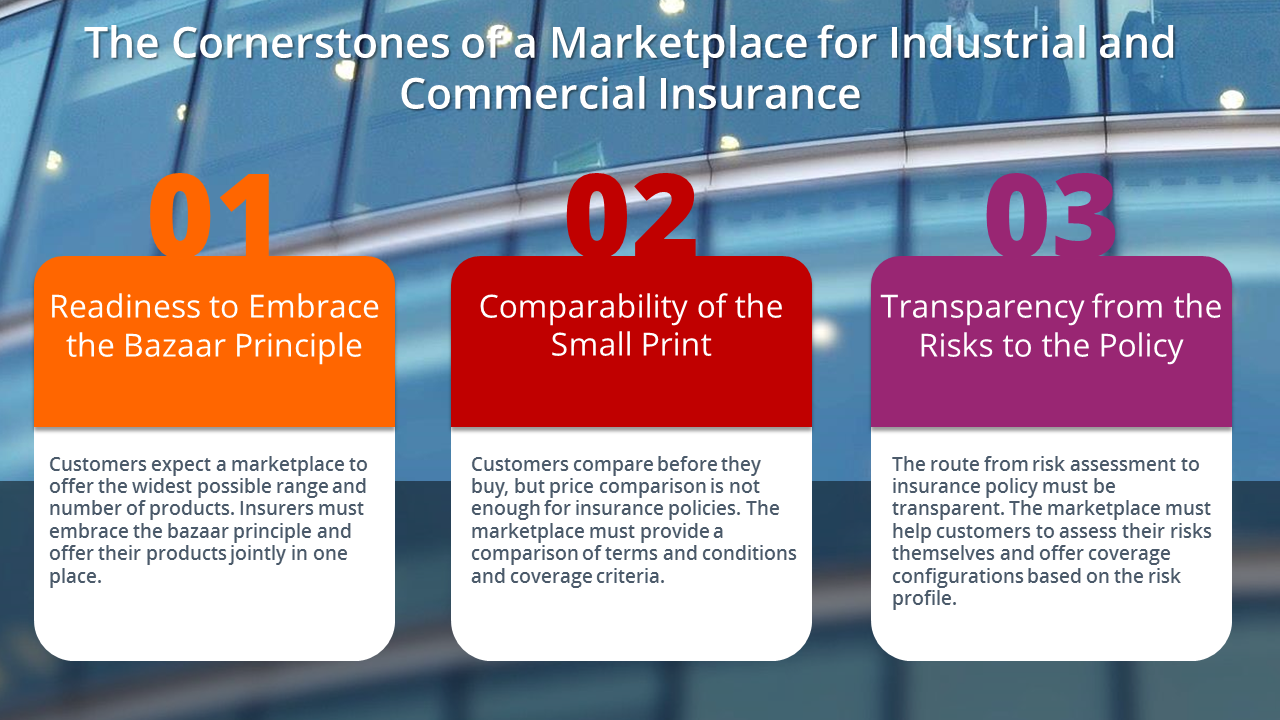Online marketplaces can revolutionize the customer interface of industrial and commercial insurance for small and midrange businesses (SMBs). But if a marketplace is to prevail it must provide a transparent comparison of insurance products and support a collaborative market presence of the industry’s major players.
In the first part of the series we explained why the outlook for setting up a marketplace that is accepted across the industry currently looks so good. In this second part we take a first look at the steps that are required for establishing an insurance marketplace and what shape it might take.
The prospects for industrial insurers jointly establishing a marketplace are better today than ever before. It is, however, unlikely that a single insurer will succeed in setting up an Amazon or Ali Baba of industrial insurance. An extensive product offering and vendor-neutral presentation are indispensable for gaining customer acceptance. What, then, are the steps that must be taken to set up a marketplace?
Agreement on the Bazaar Principle
A key step is for insurers to be ready to rely on the bazaar principle and to offer their products jointly in one place. In a bazaar, businesses in the same category are all to be found in one place. The dealer in spices has his stall next to that of another spice dealer. On the same basis, insurer A’s D&O policy offering must be located right alongside other D&O policies that are offered by insurers B, C, and D.
A clear commitment to this principle of juxtaposition is promoted by the industry’s fundamentally collaborative attitude. There are, of course, some customers that everybody would like to be theirs, but insurers by and large have their individual risk appetites and different portfolios.
The bazaar principle ensures that every salesman can see his immediate competition. The result is a kind of arms race of product presentation
The bazaar principle ensures that every salesman can see his immediate competition. The result is a kind of arms race of product presentation that has been apparent in eCommerce for some time. Without easy-to-understand descriptions and attractive product photos a fashion retailer, for example, can forget about going online with his business. The insurance industry too can only benefit from effects of this kind that are a consequence of better communication of the offering – because the bazaar principle promises more business for everybody.
Products must be Comparable: Farewell to “Black Box” Terms and Conditions
Customers have learnt first to compare and then to buy. But what exactly does “compare” mean in relation to insurance products? Price comparison alone falls short of the mark. Terms and conditions and coverage criteria must be taken into consideration to find out which product is best suited for the customer’s needs.
But how is one to compare the small print? The obvious approach is to standardize wording structures. The online marketplace provider could, for instance, define a wording structure that insurers must use in their terms and conditions. Alternatively, insurers could set up a body to draw up a common structure. A further approach could be to offer and price “atomized” cover in place of previous wordings that correspond in content to a risk coverage bundle. The customer would then put his own insurance cover together, assisted by recommendation engines that have been around for years in eCommerce (“Customers with a similar risk profile also purchased the following cover…”). In principle, this is comparable to the product configurators used in, say, the automobile industry.
eCommerce standards also open up entirely new forms of comparability for insurance products in marketplaces. Customer ratings kick in as an important purchase decision-making criterion. The most successful products are designated as top sellers. “Customers who bought this article also bought …” recommendations can also boost business.
Comparison as a Business Model: The Insurtech Sobrado
Automated comparisons are currently an exciting innovation area in the insurance business where startups abound. A case in point is the Swiss company Sobrado, which simplifies dealing with tenders and offers for brokers. They only have to specify the parameters for a tender once. The platform then converts the data into the insurers’ preferred format, which they can then simply feed into their systems. The platform finally offers brokers an automated comparison of the insurers’ offers received. This is where the business model kicks in. Brokers pay between 39 and 259 francs for a comparison. Otherwise they must undertake the comparison manually, which experience shows as taking an hour or two per comparison. With over 1,000 tenders in the first quarter of 2017 Sobrado’s business was up by 300 percent on Q1 2016.
Transparency from Risk Calculation to Insurance Policy
Along with vendor neutrality and a wide range of offers, a transparent route from risk calculation to the insurance policy plays a decisive role. Until now this part of the route has not always been clear for the customer. Customers answer a number of questions and receive specific policies based on their answers. Which answer is reflected in which risks and how they affect the policy is a mystery for SMBs without a risk manager or an in-house broker.
So a customer-centered approach would begin with a comfortable and transparent risk calculation. A marketplace would have the task of helping customers to self-assess risks by means of a meaningful visualization, making the assessment of risks from the description of the company and mapping these risks to find matching cover transparent. A mere listing of products would be less helpful.
The marketplace could offer customers a kind of risk account that draws up a risk profile on the basis of the description of the company
In this way the marketplace could offer customers a kind of risk account that draws up a risk profile on the basis of the description of the company. To help customers to assess their risks the platform could fade in additional information such as statistics on selected risks or how other policyholders have covered themselves in similar cases.
On the basis of the risk profile a range of coverage configurations could be offered that the customer could simply adjust accordingly. Customers might conceivably increase or decrease the sum insured by means of a mouse click or compare and select cover modules from different insurers.
In addition to configurations by the customer – consisting of risk profile and cover configuration –, insurers and independent experts would have to be able to offer customers configurations of their own. Along eCommerce lines ratings for entire configurations or modules would be conceivable to enable other customers to benefit from these assessments.
Trusting Partnership for a Collaborative Market Presence
It is possible for competitors to pull together, as demonstrated by joint approaches in other areas, such as private health insurance. Debeka, for example, has joined forces with Concordia Kranken and HUK-Coburg-Kranken to set up the KV Fux online comparison portal. The portal compares vendor-neutrally the premiums of 30 insurers who account for 98 percent of the market.
For a marketplace for industrial insurance to achieve a breakthrough a critical mass of insurers would need to advocate these principles explicitly in a similar way. Semantics could prove helpful, given that the mere concept of digitization has hitherto succeeded in making technical innovation acceptable at the boardroom level.








